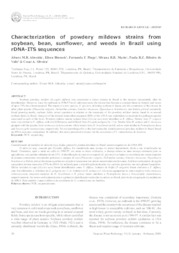Characterization of powdery mildews strains from soybean, bean, sunflower, and weeds in Brazil using rDNA-ITS sequences.
Characterization of powdery mildews strains from soybean, bean, sunflower, and weeds in Brazil using rDNA-ITS sequences.
Author(s): ALMEIDA, A. M. R.; BINNECK, E.; PIUGA, F. F.; MARIN, S. R. R.; VALLE, P. R. Z. R. do; SILVEIRA, C. A.
Summary: Soybean powdery mildew (Erysiphe diffusa) was considered a minor disease in Brazil in the decades immediately after its identification. However, since the outbreak in 1996/97 in all cultivated areas the disease has become a constant threat to farmers and losses of up to 25% have been reported. The report of a new species, E. glycines, infecting soybean in Japan, and the occurrence of the disease in other plant species (Phaseolus vulgaris, Helianthus annuus,Sonchus oleraceus,Hypochaeris brasiliensis, and Bidens pilosa) commonly found growing nearby soybean fields, raised questions in relation to the taxonomy of the powdery mildew strains found in or around soybean fields in Brazil. Analysis of the internal transcribed sequence (ITS) of the rDNA was undertaken to ascertain the pathogen species associated to each of the hosts. Powdery mildew strains isolated from Glycine max were identified as E. diffusa. Strains from P. vulgaris were very similar to E. diffusa, with 4 nt differences, and differed from Erysiphe poligony by 11 nt. Strains from H. annuus and S. oleraceus grouped with the species Golovinomyces cichoracearum, while strains from H. brasiliensis and B. pilosa were similar to Podosphaera fusca and Neoerysiphe cumminsiana, respectively. To our knowledge this is the first molecular identification of powdery mildew in Brazil based on rDNA sequence comparison. In addition, this study presented evidence for the occurrence of N. cumminsiana in America.
Publication year: 2008
Types of publication: Journal article
Unit: Embrapa Soybean
Observation
Some of Embrapa's publications are published as ePub files. To read them, use or download one of the following free software options to your computer or mobile device. Android: Google Play Books; IOS: iBooks; Windows and Linux: Calibre.
Access other publications
Access the Agricultural Research Database (BDPA) to consult Embrapa's full library collection and records.
Visit Embrapa Bookstore to purchase books and other publications sold by Embrapa.

